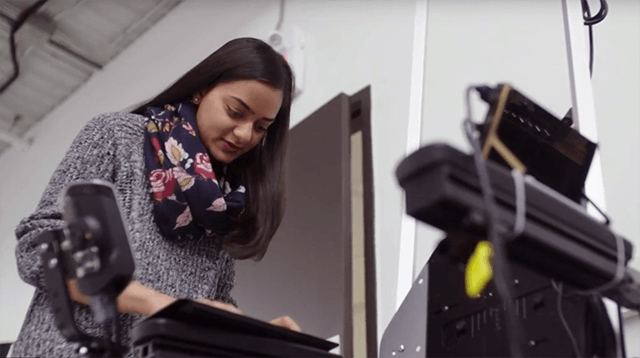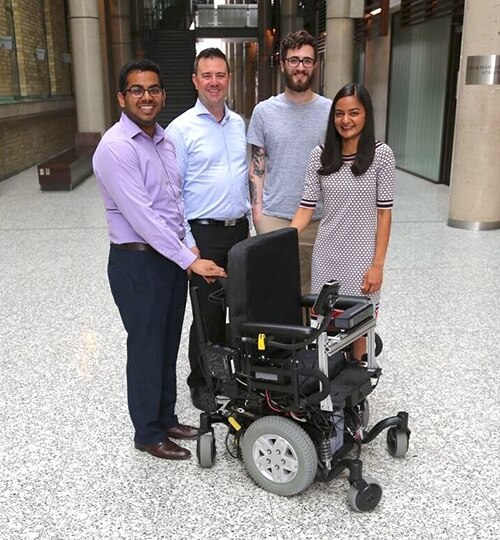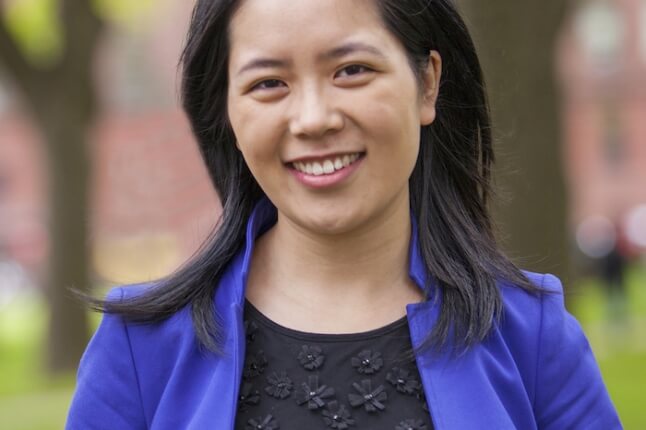News
Maya Burhanpurkar co-founded a startup, Adventus Robotics, that enables autonomous power wheelchairs. (Photo provided by Maya Burhanpurkar)
Millions of power wheelchair users are especially vulnerable to disease in hospitals and airports. By law, they are provided with porters who push them around the facility, often for hours at a time. This can become a serious flashpoint for transmission of pathogens such as COVID-19, risking the health of both vulnerable elderly passengers and the porters who assist them.
To reduce this potentially fatal risk factor, a Harvard student has developed an autonomous wheelchair that eliminates the need for porters, freeing them to be re-deployed to more useful tasks.
“Porters are human, so they often end up arriving late. In a study with Toronto General Hospital, in the imaging department alone, because of late arrival times over the course of one year, the hospital loses out on about $6 million due to machine idle time,” said Maya Burhanpurkar, A.B. ’21, a physics and computer science concentrator.
By enabling autonomous power wheelchairs, the startup Burhanpurkar co-founded, Adventus Robotics, aims to make the way patients are moved around a hospital dramatically more efficient. Adventus Robotics won the gold medal in the commercial track in this year’s i3 Innovation Challenge, sponsored by the Technology and Education Center at the Harvard John A. Paulson School of Engineering and Applied Sciences.
Helping to prevent the spread of a pandemic is a use case Burhanpurkar didn’t envision when she started working on this technology during a gap year at the University of Toronto before she arrived at Harvard.
She and her colleagues developed a system that involves retrofitting an existing power wheelchair with a number of sensors, such as cameras, inertial measurement units, odometers, and Light Detection and Ranging (LiDAR) devices. Using data from those sensors, an artificial intelligence-driven software package enables the wheelchair to move autonomously based on user commands.
“It is rarely good enough to have just one sensor. Different sensors have different noise profiles. Some will be really accurate after you turn them on and then slowly get less accurate. Others just consistently have some error, so there is a real art to fusing this data together,” she explained. “But if you are able to do that, you can make a map of your environment, and you can also, based on the wheelchair’s motion, simultaneously locate yourself within this map.”
Adventus Robotics offers two different software packages. The first is a fully autonomous package for use in environments where the individual spends a lot of time, like the home. A caretaker pushes the wheelchair around the house to build a map of the environment, after which the user can command the system to move to any specific location, like the bathroom or kitchen.
The second package is designed to help users with particularly difficult navigational tasks, such as moving down a long corridor (which requires holding a joystick down for an extended period of time) or parking at a desk or dining table (where the proximity of obstacles presents a major challenge.) A user navigates a wheelchair into the general proximity of an obstacle—in front of a narrow doorway, for instance—and then the semi-autonomous system completes the navigational task.
After spending years perfecting the software, and conducting dozens of tests of many different situations, Burhanpurkar said the time was right to launch the startup. She and her co-founders hope to work directly with hospitals, partner with major wheelchair manufacturers, and market their product directly to consumers.
They were set to complete hospital pilot studies over the past few months, but the COVID-19 pandemic, and the burdens it has placed on the health care system, have put their plans on hold for now.
But Burhanpurkar and her colleagues are continuing to speak with potential customers and plan additional validation studies in the future.
The prospect of seeing this technology actually helping people is the driving force that pushes her through these tough times.
“Four years ago, we were really still in the development stage. The chair worked really well, except in those few corner cases that were just really difficult to deal with. If you’d asked me then whether I thought this would be something that would be in the hands of consumers in the next decade, I would have said ‘maybe not’ because there seemed to be some pretty hefty technological challenges,” she said. “But we persevered. The most rewarding thing has been working on this for so long and finally coming up with something that can actually have an impact on the world.”
Topics: AI / Machine Learning, COVID-19
Cutting-edge science delivered direct to your inbox.
Join the Harvard SEAS mailing list.
Press Contact
Adam Zewe | 617-496-5878 | azewe@seas.harvard.edu




